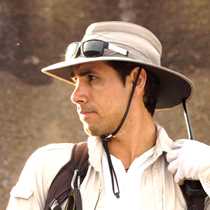The National Geographic Islander repositioned to the southeastern corner of the archipelago, and the island we visited today happens to be the first island visited by Charles Darwin in 1835. Our visitor’s site for the morning is called Punta Pitt, named after a British admiral back in the 1800s. This site is an eroded tuff cone that today serves as nesting site for red-footed boobies, frigatebirds, red-billed tropics birds and many more sea birds.
In the afternoon, we visited another large tuff formation called Cerro Brujo, where our guests had the chance to explore the long white sand beach at the base of the formation. Swimming was a very popular activity, and many of our young explorers went bodysurfing in the very gentle waves along this beautiful beach.







